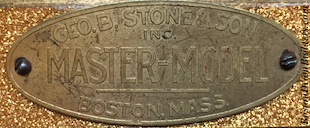After discussing tension nuts, snare strainers, butt plates, and grommets in Part I, this second installment will detail additional characteristics by which to more accurately identify and date George. B. Stone & Son Master-Model drums.
Badges
Plain brass or silver badges were generally reserved for more special drums such as those wrapped in Pyralin finishes, or the all-metal Master-Model drums built around solid aluminum shells. On all-metal Master-Model drums, the badge is usually affixed directly onto the shell rather than the top counterhoop.
 early Master-Model Drum Badge, ca. 1922 |  early Master-Model Drum Badge, ca. 1923 |
 All-Metal Master-Model Drum Badge, ca. 1925 |  Pearl Wrapped Master-Model Drum Badge, ca. 1930s |
Late in Stone's manufacturing days of the 1930s, a significant number of common single tension field drums were assembled with Master-Model badges installed. While it is possible that Stone cataloged a Master-Model field drum in the late 1930s, it is more likely that the factory was merely using up their leftover stock of Master-Model badges. A decade earlier, these instruments never would have been considered by Stone to be true "Master-Model" drums as none of the other characteristic elements of the Master-Model drums are to be found in these instruments.
Labels and Date Stamps
Makers labels were typically applied to the inside of Stone Master-Model shells across from the air vent so that they could be viewed by peering through the grommet. Sometimes labels were placed right side up, and sometimes they were placed upside down. There does not appear to be a specific pattern to or method by which the labels were applied.
Date stamps were commonly applied to Stone Master-Model labels up through mid 1925 by which time the serial numbers had reached the low 7000 range. After 1925, the practice of date stamping ceased while the use of serial numbers continued as the four digit numbers would ultimately climb into the high 9000 range. It should be noted that these four digit serial numbers were applied to all Stone shells, not just the Master-Models. The same is true of date stamps from the same time period of 1922 - 1925.
 Master-Model Label, 1923 |  Master-Model Label, ca. 1926 |
 Master-Model Label, late 1920s - early 1930s |  Master-Model Label, mid 1930s |
Master-Model Numbers and Pencil Markings
Geo. B. Stone & Son kept a running count of exactly how many Master-Model drums were being produced. Most Master-Models have a two or three digit number marked somewhere inside of the shell. This is the Master-Model number. The method by which the Master-Model numbers were marked inside of the drums is inconsistent. The most commonly seen marking is a small three digit number hand written in pencil at the bottom of each drum label.
 |  |
Sometimes the Master-Model number was also handwritten in pencil near one or both bearing edges inside the drum. At other times the number is stamped into the wood in a similar fashion to how the serial numbers were imprinted only with much smaller numerals. Sometimes both of the markings are present simultaneously. (Example 1)
Often times, the shell and the wooden counterhoops were marked with the same number telling us that the Stone factory workers matched the hoops specifically to each individual drum. (Examples 2a and 2b)
Complicating this numbering system is the way that the factory kept track of matched pairs of hoops with very similar pencil markings. Sometimes these numbers match the drum but many times they do not. Sometimes the two hoop numbers match each other, but other times they correspond only to a specific side of a particular drum and do not correlate with the Master-Model numbering system. (Example 3)
 Example 1 |  Example 2a |
 Example 2b |  Example 3 |
It can be difficult to discern the difference between Stone's hoop numbers and the Master-Model numbers. The hoop numbers are typically one or two digits, marked only in pencil. Master-Model numbers are usually two or three digit numbers and are marked elsewhere in the shell and hoops. Thus confusing the hoop numbers with the Master-Model number is really only an issue with the first one hundred drums where a two digit hoop number could be mistaken for a two digit Master-Model number, or in cases where a Master-Model number can not be found.
Preservation and Provenance
Care should be taken when disassembling a Stone Master-Model drum so as not to accidentally obscure or remove any of the original pencil markings inside of the drum and on the underside of the wooden counterhoops. Removing these small pieces of evidence left behind by a factory worker nearly a century ago takes away from the story of each individual drum and its unique provenance.
If you are the owner of a Stone Master-Model Drum, please write to me! For several years now I have been compiling a listing of Master-Models which currently includes more than three dozen instruments. With each drum documented, more is learned about George B. Stone & Son as a manufacturer, and about the evolution of the company's production capabilities. This is especially important seeing as no original Stone serial number listing exists. Any records kept by the company have long since been lost or destroyed. This is why, by recording information about each drum as it is discovered, we can paint an ever clearer picture of the full history of these wonderful drums and the company that produced them.
Lee can be contacted any time by email at lee@vinson.net.
And for more on the Boston Drum Builders of the early 20th century, please visit BostonDrumBuilders.com.

